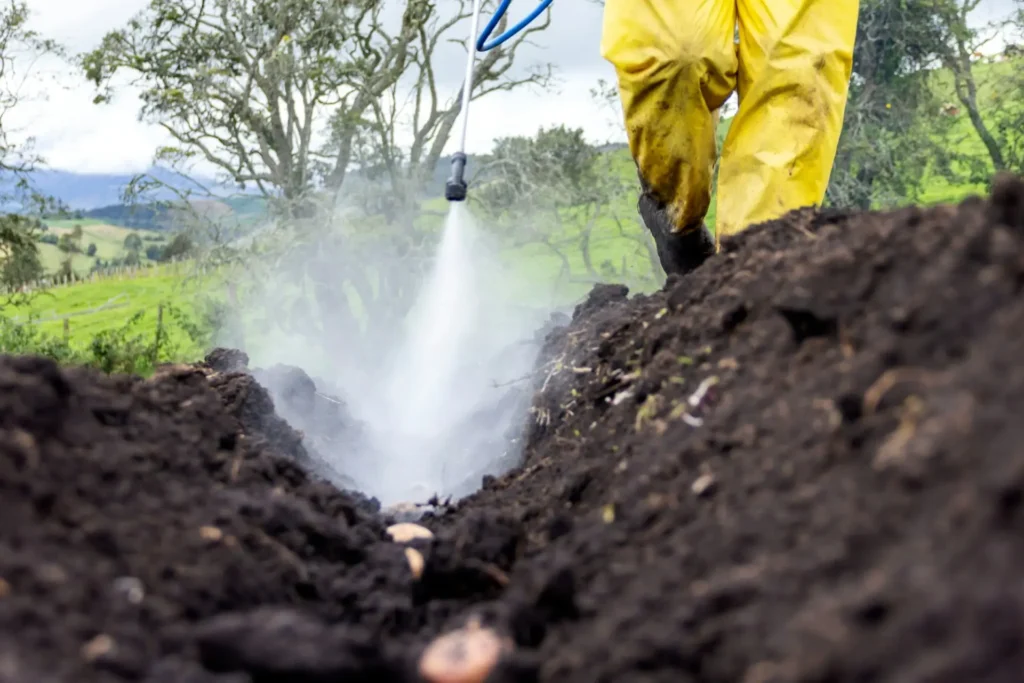
Introduction: The Foundation of a Bountiful Harvest
The success of a harvest begins long before the first seed is planted. Healthy soil is critical for high-value crops like strawberries, potatoes, and onions. Healthy, vibrant soil is the foundation for high yields and exceptional quality. However, this foundation is constantly under threat from soil-borne pests, pathogens, and aggressive weeds that can decimate a crop before it even has a chance to grow.
This is where soil fumigation becomes a critical tool in a grower’s arsenal. When done correctly, it provides a clean slate, eliminating harmful organisms to give your crop the best possible start. This guide will walk you through the most effective practices, from preparation to post-treatment recovery, to help you optimize your approach for maximum success.
Preparing for Success: Pre-Fumigation Best Practices
Effective fumigation is all about preparation. The treatment will be less effective without the right soil conditions, leading to inconsistent results and wasted resources.
- Soil Preparation: Begin by thoroughly tilling the soil to a depth of at least 8 to 12 inches. Breaking up any large clods is crucial, as they can prevent the fumigant from spreading evenly. The finer the soil texture, the better the result.
- Timing and Moisture: The timing of your fumigation is critical and depends on soil temperature. Fumigants work best in warm, moist soil, typically between 50°F and 75°F. The soil should be at a moisture content of 50-75% of field capacity—moist enough to hold its shape when squeezed, but not so wet that water drips out.
- Equipment Calibration: Ensure your application equipment is calibrated correctly to deliver the correct rate of fumigant uniformly across the field. Incorrect application rates can lead to under-treated areas where pests can thrive.
Crop-Specific Fumigation Strategies
The best approach to soil fumigation isn’t a one-size-fits-all solution. Each crop has unique vulnerabilities and growing requirements.
- Strawberry Cultivation: Strawberries are particularly susceptible to soil-borne pathogens like Fusarium and Verticillium wilt, which can cause significant crop loss. Strawberry cultivation requires a pristine environment for new transplants to establish healthy root systems. Fumigation is essential for clearing the soil of these threats, ensuring a strong plant start and a high-quality fruit yield.
- Potato Fumigation: The primary targets of fumigation for potatoes are nematodes and Verticillium wilt, which can damage tubers and reduce yield and quality. Effective potato fumigation helps produce a cleaner, smoother-skinned potato that fetches a better price at market.
- Onion Fumigation: Onions are vulnerable to diseases like white rot and pink root. These pathogens can persist in the soil for years, challenging them. Onion fumigation is vital in controlling these persistent threats, ensuring a healthy growing season for a crop that requires a long maturation period.
The Aftermath: Recovering Soil Health Post-Fumigation
While soil fumigation effectively eliminates harmful organisms, it can temporarily disrupt the delicate balance of beneficial microbial life. The key to long-term success is to kill the bad and actively restore the good.
- Microbial Restoration: Post-fumigation, the soil is an empty ecosystem. This presents a prime opportunity to rebuild a healthy microbial community. Incorporating high-quality organic matter and utilizing beneficial microbial products is the most effective way to kick-start this process.
- A Solution from Pharmgrade: To help growers rebuild their soil’s health, products from Pharmgrade are designed to reintroduce beneficial bacteria and fungi, restoring the natural microbial balance. Using such products helps your soil bounce back quickly, improving nutrient uptake, enhancing plant immunity, and creating a more resilient growing environment.
About PharmGrade: Our Commitment to Sustainable Agriculture
For 30 years, Pharmgrade has been a leader in creating breakthrough, sustainable products for the fertilizing industry. Our mission is to help nature, not by force, but by understanding its delicate balance and processes. We achieve this by designing and creating natural products that promote superior soil health, increased fertility, and stronger yields. Our proprietary blends combine naturally occurring microbes with organic acids and nutrients. We are committed to a team approach, working with field consultants, dealers, and farmers who share our concern for the future of sustainable agriculture. At PharmGrade, we take great pride in our products and our team’s dedication to building sustainable soils for the future.
View Our Products
Conclusion: A Holistic Approach to Modern Farming
Modern farming demands a holistic approach. While pest management tools like soil fumigation are necessary, they must be part of a larger strategy that includes a strong focus on soil health. By combining meticulous soil preparation, crop-specific fumigation techniques, and a proactive plan for microbial recovery, growers can create a sustainable cycle of high-yield, high-quality crops. This balanced approach ensures a bountiful harvest year after year.
Frequently Asked Questions
Q: How soon after fumigation can I plant my crop?
A: The “plant-back” interval depends on the fumigant, soil type, and temperature. Always follow the manufacturer’s label instructions carefully. It can range from a few days to several weeks.
Q: Is soil fumigation harmful to the environment?
A: When applied according to label directions and best practices, modern fumigants are designed to break down in the soil without leaving harmful residues. Proper timing and application techniques are key to minimizing any environmental impact.
Q: Can I use fumigation as a standalone solution?
A: No, fumigation is most effective when used as part of an Integrated Pest Management (IPM) strategy that also includes crop rotation, sanitation, and the use of resistant plant varieties.
Disclaimer
The information provided in this blog post is for educational purposes only and is not intended to be a substitute for professional agricultural advice. Always follow local and federal regulations and the specific label instructions for any product you use. Consult a farming expert to determine the best strategy for your crop and soil conditions.
Ready to Optimize Your Soil?
Visit our website and explore our range of products for more information on how to build a healthier, more resilient soil ecosystem after fumigation.
